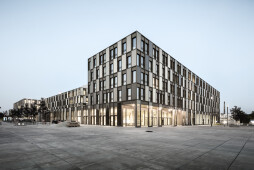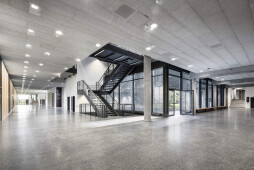At the University of Applied Sciences in Bielfeld, 36,000m² of Knauf Ceiling Solutions wood wool acoustic panels enhance the acoustics within an impressively large open landscape for learning.
The challenge for the architects was to encourage communication and interdisciplinary collaboration within shared spaces where people come together, whilst also reducing reverberation and ensuring a good level of acoustic control.
The Auer Weber planning team found what they were looking for at Knauf Ceiling Solutions, using HERADESIGN® Superfine 35mm thick wood wool acoustic panels made of magnesite bonded wood and water. The architects used a metal CD supporting structure to suspend 36,000m² of wood wool panels (2200×550mm) from the ceiling. Optimal sound absorption each type of room was achieved by varying the suspension height and using different thicknesses of mineral wool insulation as a lining between the ceiling itself and the acoustic panels.
The result: It is noticeably quieter in the lecture theatres, the corridors, seminar rooms and open-plan learning and meeting spaces and students can relax and talk to each other at a low volume.
More from the Manufacturer:
Bielefeld University has almost 9,700 students and is the largest publicly-funded university in the East Westphalia-Lippe. Until then its faculties had been distributed over several locations. This all changed with the opening of the new building in Campus North during the winter semester of 2015/16.
31,500m² of floor space house 16 lecture theatres, 220 seminar rooms, a library, laboratories, computer centre, two café bars and a cafeteria with outdoor seating. "The Bielefeld University of Applied Sciences has been given its own specific address and a new look on the Bielefeld campus," said Beate Rennen-Allhoff, President of the Bielefeld University of Applied Sciences. "For the first time, the different university disciplines can engage in teaching, learning and research under one roof—with an outstanding infrastructure and the latest equipment." The students belong to the Engineering Science, Mathematics, Social Studies and Business Studies faculties.
Large Open Landscape for Learning
The creative forces of Auer Weber, the Munich architectural firm, are behind the construction of the new building. They have designed the building so that it features a feeling of openness to encourage communication and interdisciplinary collaboration. There are large spaces where people can come together to share ideas, courtyards flooded with light and wide corridors that are attractive and inspirational to walk along.
However, this openness presented the architects with the acoustic challenge of reducing reverberation. "At an early stage, we decided to install a suspended ceiling throughout the building to offer students a quiet and pleasant acoustical environment," reflected Thomas Schonder, architect at Auer Weber. This is how the search for a suitable ceiling solution began.
Economical Alternative to Traditional Perforated Panels
The wood wool acoustic panels offer an economical alternative to the traditional perforated panels. "Perforated panels absorb the sound energy over a narrow frequency range and therefore architects need to incorporate additional, expensive absorbers for low-frequencies and bands to create effective acoustics," said Thomas Wölfer, Knauf Ceiling Solutions. "However, the HERADESIGN® wood wool acoustic panels combine these functions and therefore provide a more economical solution which will also last for several decades."
Wood Wool Acoustic Panels Characterised by their Visual Appearance
The architects were particularly impressed by both the high level of sound absorption of the ceiling panels and the characteristic visual appearance of the wood wool structure containing fibre which is millimetres thick. "We have intentionally used the Heradesign product which specifically caters for textured surfaces. The individualised colour scheme made it perfectly possible to coordinate with other materials," said Schonder. In this way, for example, the wide corridors with their grey ceiling panels harmonise with the grey linoleum flooring. "This design aspect was a key criteria for the choice of ceiling system."
It was also easy for the drywall builder to trim parts of the ceiling panels when integrating elements of the building services before installation. "The suspended ceiling system was supposed to be able to incorporate technical installations such as lighting, ventilation, sprinklers, fire alarms and loudspeakers," stated Schonder. In this way some spaces could have lighting channels with surface-mounted lighting, compared with the recessed lighting and running bond in large open areas. "Another product advantage transpired in that it was relatively easy to temporarily open up individual ceiling areas to perform subsequent installation work during the building phase." The company technicians are able to work more quickly due to this ability to gain access.










































